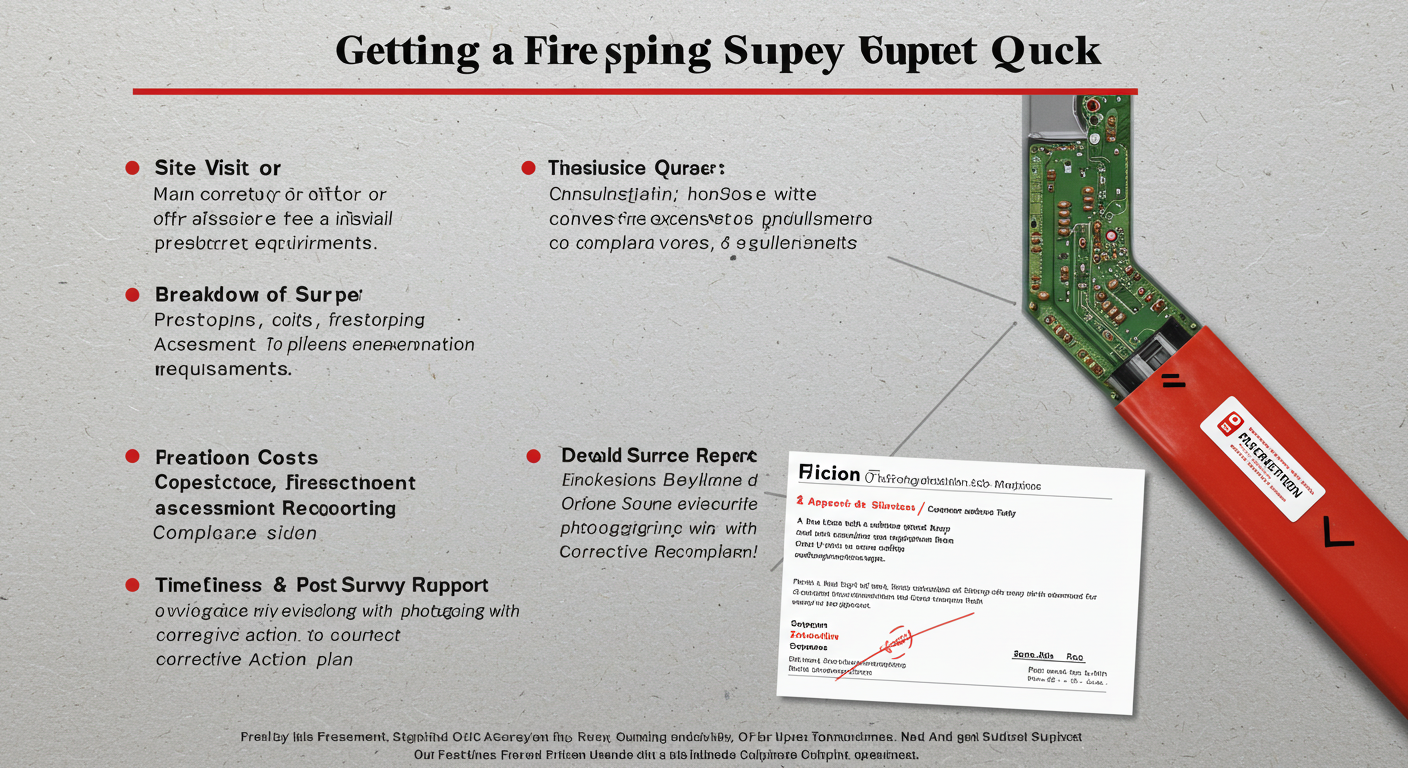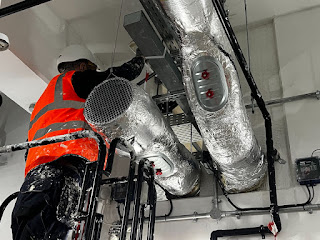Without effective fire stopping, gaps around pipes, cables, and ductwork could become hidden pathways for fire to spread, endangering lives and violating Building Regulations Part B. A professional fire-stopping survey in London identifies weak points, recommends corrective actions, and ensures your building is protected against fire hazards. Beyond compliance, it’s about proactive risk mitigation, safeguarding assets, and, ultimately, saving lives.
Understanding Fire Stopping Surveys
Fire safety isn’t just about extinguishing flames—it’s about preventing their spread. Fire Stopping Surveys are essential for identifying hidden gaps around pipes, cables, and ducts that could allow fire and smoke to spread uncontrollably. By ensuring fire barriers, seals, and passive fire protection systems are correctly installed and maintained, these surveys protect occupants, structural integrity, and legal compliance for property owners, landlords, and facility managers.
What Does A Fire Stopping Survey Involve?
A fire-stopping survey is a detailed assessment of fire-stopping measures within a building. It focuses on areas where fire and smoke could breach compartments, such as gaps around cables, pipes, ventilation systems, and structural joints. Fire surveyors inspect these points, ensuring that fire-resistant materials—such as intumescent sealants, fire collars, and cavity barriers—are correctly installed and provide the intended level of protection. The goal is to ensure effective compartmentation, preventing fire from spreading beyond a contained area and giving occupants crucial time to evacuate.
Key Components Of A Fire Stopping Inspection
A comprehensive fire-stopping inspection covers multiple elements of passive fire protection:
- Fire-Rated Walls, Floors, And Ceilings – Inspecting penetrations and joints to ensure they maintain their fire-resistant properties.
- Service Penetrations (Pipes, Cables, Ducts) – Checking for properly installed fire collars, intumescent wraps, or fire-resistant sealants around penetrations.
- Fire Doors & Frames – Ensuring they are correctly fitted with intumescent seals and smoke brushes to prevent fire and smoke spread.
- Fire Dampers & Ventilation Systems – Verifying that dampers automatically close in the event of a fire to restrict air movement.
- Cavity Barriers & Fire-Stopping Materials – Assessing fire-resistant barriers in concealed spaces, such as voids and service shafts.
How Surveys Help Maintain Compartmentation In Buildings
Fire compartmentation is a fundamental principle of fire safety, designed to contain fire within a specific zone of a building. When properly maintained, fire-rated walls, floors, and ceilings prevent fire from moving between rooms, corridors, and escape routes. However, poorly sealed service penetrations, damaged fire barriers, or incorrectly fitted fire doors can create pathways for flames and smoke, drastically reducing the effectiveness of passive fire protection. A fire-stopping survey identifies these weaknesses and provides recommendations for corrective actions, ensuring that buildings remain compliant and safe.
The Legal And Regulatory Requirements
Ensuring compliance with fire safety regulations is not just about avoiding penalties—it’s about safeguarding lives and property. Fire-stopping surveys are a critical part of meeting the required standards set by UK fire safety laws and building regulations. These regulations define how buildings must be designed, constructed, and maintained to prevent the spread of fire and smoke. Understanding these legal frameworks helps property owners, landlords, and building managers fulfil their fire safety obligations.
The Regulatory Reform (Fire Safety) Order 2005
The Fire Safety Order (FSO) 2005 is the primary fire safety legislation in England and Wales. It places the responsibility of fire risk management on the “responsible person”, which could be a property owner, employer, landlord, or building manager. This regulation mandates that fire risk assessments are conducted, including fire-stopping measures, to ensure occupants are protected in case of a fire. Non-compliance can lead to legal consequences, including fines and prosecution.
BS 476 & BS EN 1366 Compliance Standards
These British and European standards define the fire resistance testing of building materials and passive fire protection systems.
- BS 476 assesses the fire resistance of structures, walls, and partitions to determine their ability to contain fire for a specified duration.
- BS EN 1366 focuses on the fire resistance of service installations, such as ducts, dampers, and penetration seals, ensuring they meet strict fire safety criteria.
- Compliance with these standards ensures that fire-stopping materials perform effectively in real-world fire scenarios, preventing fire and smoke spread.
Fire Safety Act 2021 & Its Impact On Property Owners
The Fire Safety Act 2021, introduced in response to significant fire incidents, strengthens the Fire Safety Order (2005) by mandating fire risk assessments for fire doors, external walls, and cladding in multi-occupied buildings. It holds landlords, freeholders, and managing agents accountable for maintaining fire compartmentation, fire stopping, and passive fire protection, with non-compliance risking enforcement action by fire authorities.
Building Regulations Part B: What You Need to Know
Part B of the UK Building Regulations sets the fire safety requirements for new and refurbished buildings. It covers crucial aspects such as:
- Compartmentation And Fire Stopping – Ensuring walls, floors, and service penetrations prevent fire from spreading.
- Fire Doors And Escape Routes – Ensure designated fire doors and exits remain unobstructed and compliant.
- Fire Resistance Of Materials – Specifying minimum fire resistance levels for structural elements. Adhering to Part B is essential for obtaining building approval, and fire-stopping surveys help ensure compliance with these regulations.
Who Needs A Fire Stopping Survey?
Fire safety is a shared responsibility, and ensuring proper fire-stopping measures is essential for various stakeholders, from property owners to construction teams. A fire-stopping survey helps identify fire compartmentation issues, ensuring compliance with UK fire safety laws while protecting people and property. Here’s who needs a fire-stopping survey and why it’s crucial for them:
Property Owners & Landlords
Property owners and landlords must ensure fire safety compliance, including compartmentation and fire-stopping. Under the Regulatory Reform (Fire Safety) Order 2005, they are responsible for fire risk assessments and maintaining fire barriers, doors, and service penetrations to prevent fire spread. A fire-stopping survey ensures compliance, reduces liability and protects tenants.
Construction & Renovation Projects
In any new build, refurbishment, or renovation, proper fire-stopping installation is critical to meeting Building Regulations Part B. Contractors must ensure that service penetrations, fire doors, fire-resistant walls, and ceilings are correctly sealed to maintain fire compartmentation. A fire-stopping inspection helps verify that fire-stopping systems have been installed correctly, preventing costly remedial work or compliance failures later.
Commercial Buildings & Facility Managers
Businesses, offices, shopping centres, hotels, and industrial premises must comply with fire safety laws to protect employees, customers, and assets. Facility managers are responsible for maintaining passive fire protection systems, including fire doors, dampers, and cavity barriers. Regular fire-stopping surveys help detect weaknesses, ensure compliance with BS 476 & BS EN 1366, and support a safe evacuation strategy in case of a fire.
Local Authorities & Housing Associations
Councils and housing associations manage multi-occupied buildings, including high-rise flats, social housing, and care homes, where fire safety is paramount. The Fire Safety Act 2021 has reinforced the responsibility to assess fire doors, cladding, and compartmentation systems. A fire-stopping survey helps identify fire risks, ensuring compliance with UK fire safety standards and improving occupant protection.
Common Fire Stopping Deficiencies Found During Inspections
A fire-stopping survey is designed to identify weaknesses in a building’s passive fire protection system, ensuring that fire and smoke cannot spread uncontrollably. Over time, wear and tear, poor installation, or inadequate maintenance can compromise fire compartmentation, putting occupants and property at risk. Here are the most common fire-stopping deficiencies found during inspections and why they need urgent attention:
Unsealed Service Penetrations in Walls, Floors & Ceilings
Electrical cables, pipes, and ductwork often pass through fire-rated walls, floors, and ceilings, creating potential fire and smoke pathways if they are not adequately sealed. Unsealed penetrations can cause fire to spread rapidly between compartments, reducing escape time for occupants. A fire-stopping inspection ensures these openings are correctly sealed with fire-resistant materials, such as intumescent sealants, fire collars, and wraps, to restore fire integrity.
Read Also: Responsible Waste Management With Skip Hire In Deptford: Following The Waste Hierarchy
Incorrect Or Damaged Fire Stopping Materials
Using non-compliant, outdated, or damaged fire-stopping materials can drastically reduce a building’s fire resistance. In some cases, incorrect installation—such as applying the wrong type of sealant or failing to install fire collars around pipes—renders fire protection ineffective. A fire-stopping survey helps identify these weaknesses and recommends approved fire-resistant solutions that comply with BS 476 & BS EN 1366 standards.
Inadequate Fire Protection Around Cables, Pipes & Ductwork
Service penetrations need correctly rated fire-resistant protection to prevent fire and smoke from spreading through voids and hidden cavities. Fire-rated ductwork, fire dampers, and intumescent pipe wraps must be installed correctly and inspected regularly to maintain effectiveness. Without proper fire stopping, ventilation and cable routes can act as hidden highways for fire to travel between rooms, floors, and escape routes.
Gaps Around Fire Doors & Frames
Fire doors are designed to contain fire and smoke within a compartment, but if there are gaps around frames, missing intumescent strips, or damaged seals, their effectiveness is compromised. A fire-stopping inspection checks that fire doors close correctly, seals are intact, and smoke leakage is prevented, ensuring that occupants have enough time to evacuate safely.
Poorly Maintained Fire-Rated Partitions
Over time, fire-rated walls, ceilings, and partitions can develop cracks, holes, or structural damage that reduce their fire resistance. In some cases, previous building modifications may have breached compartmentation without proper fire-stopping repairs. A fire-stopping survey helps identify these weak points, ensuring walls and ceilings maintain their required fire-resistance rating in accordance with Building Regulations Part B.
How Fire Stopping Surveys Help Reduce Fire Risks
A fire-stopping survey is crucial in minimising fire hazards by ensuring that passive fire protection systems are correctly installed and maintained. By addressing fire-stopping deficiencies, these surveys enhance a building’s overall fire safety strategy and compliance with UK fire regulations.
Preventing the Spread Of Fire & Smoke Between Compartments
Effective fire compartmentation prevents fire and smoke from travelling through walls, floors, and service penetrations, limiting its spread and reducing damage. Fire-stopping surveys identify weaknesses in fire barriers, penetrations, and sealing materials, ensuring that fire remains contained within designated areas.
Ensuring Safe Evacuation Routes Remain Uncompromised
Fire and smoke can obstruct escape routes, making evacuation dangerous. A fire-stopping survey ensures that fire doors, corridors, and stairwells remain protected by adequately installed fire-resistant materials, giving occupants enough time to evacuate safely in the event of a fire.
Enhancing Building Fire Resistance & Structural Integrity
Fire can weaken a building’s structure, leading to collapse and extensive damage. Fire-stopping measures, such as intumescent coatings, cavity barriers, and fire-rated partitions, help maintain the building’s fire resistance, protecting occupants and property.
Choosing A Fire Stopping Survey Provider In London
A fire-stopping survey follows a structured process to assess, document, and improve a building’s passive fire protection measures. From initial inspection to compliance recommendations, this process ensures that fire barriers, compartmentation, and fire-stopping materials are correctly installed and maintained to meet UK fire safety regulations.
Step-by-Step Breakdown Of A Fire Stopping Survey
A professional fire-stopping inspection typically includes the following:
- Site Assessment – Evaluating the building layout, fire compartments, and potential fire spread risks.
- Inspection Of Fire Barriers – Examining walls, floors, ceilings, and penetrations for gaps, breaches, or inadequate fire stopping.
- Assessment Of Service Penetrations – Checking cables, pipes, and ductwork for proper fire-resistant sealing.
- Verification Of Fire Doors & Dampers – Ensuring fire doors and ventilation systems meet fire resistance requirements.
- Material & Installation Checks – Assessing fire-resistant materials for correct installation and compliance.
What Happens After The Inspection?
After the fire-stopping survey, a detailed report is compiled, outlining:
- Identified fire-stopping deficiencies and non-compliance issues.
- Areas requiring remedial work or fire-stopping upgrades.
- Recommendations for ensuring fire compartmentation effectiveness.
Understanding Fire Stopping Survey Reports
A fire-stopping survey report provides:
- Photographic evidence of fire safety issues.
- Location-specific findings to pinpoint fire risks.
- Compliance assessment against BS 476, BS EN 1366, and UK fire safety laws.
- Corrective action plan for rectifying deficiencies.
Next Steps For Ensuring Compliance
To maintain fire safety compliance, property owners and facility managers should:
- Address identified fire-stopping issues by hiring certified fire-stopping contractors.
- Follow regulatory recommendations from the survey report.
- Schedule periodic fire-stopping inspections to maintain ongoing compliance.
- Ensure fire-stopping installations meet Building Regulations Part B and other legal standards.
The Fire Stopping Inspection & Reporting Process
A fire-stopping inspection is a crucial step in ensuring that a building’s passive fire protection measures are effective and compliant with UK fire safety regulations. The process involves a detailed assessment of fire barriers, penetrations, and fire-stopping installations, identifying any weaknesses that could compromise fire compartmentation. A comprehensive inspection and report provide actionable insights to rectify fire safety risks and maintain compliance.
Step-by-Step Breakdown Of A Fire Stopping Survey
A professional fire-stopping survey typically follows these stages:
- Initial Assessment – Reviewing the building’s fire strategy and identifying key fire-stopping areas.
- Inspection of Fire Barriers & Compartmentation – Checking walls, floors, and ceilings for breaches or unsealed service penetrations.
- Evaluation of Fire-Stopping Materials – Verifying the installation and condition of intumescent sealants, fire collars, wraps, and cavity barriers.
- Assessment of Fire Doors & Frames – Ensuring proper sealing and functionality to contain fire and smoke.
- Fire Damper & Ductwork Inspection – Checking ventilation systems for compliant fire-resistant barriers.
- Photographic & Documentation Recording – Capturing visual evidence and noting compliance status for each inspected area.
What Happens After The Inspection?
Once the fire-stopping survey is completed, the findings are analysed, and a comprehensive fire-stopping report is prepared. This report details:
- Areas that meet fire safety standards and those that require improvement.
- Fire safety risks due to damaged or missing fire-stopping materials.
- Recommendations for corrective actions to restore fire compartmentation integrity.
Understanding Fire Stopping Survey Reports
A fire-stopping report provides a clear breakdown of fire safety issues and compliance status, typically including:
- Detailed findings with photographic evidence of non-compliant areas.
- Fire resistance ratings of inspected barriers and materials.
- Remedial actions are needed to meet BS 476, BS EN 1366, and Building Regulations Part B.
- Priority recommendations to address critical fire-stopping deficiencies.
Next Steps For Ensuring Compliance
After receiving the fire-stopping report, property owners and facility managers should:
- Implement recommended fire-stopping improvements using certified contractors.
- Ensure materials and installations meet UK fire safety standards.
- Schedule periodic fire-stopping inspections to maintain ongoing compliance.
- Keep records of all fire-stopping measures and corrective actions to demonstrate due diligence.
The Role Of Passive Fire Protection In Fire Stopping
Passive fire protection (PFP) is a critical component of a building’s fire safety strategy, designed to contain, slow down, and limit the spread of fire and smoke. Unlike active fire protection (AFP), which includes alarms and sprinklers that react to fire, passive fire protection is built into the structure, providing continuous fire resistance without human intervention. Proper fire stopping ensures that fire-rated materials, barriers, and compartmentation systems remain effective in protecting occupants and assets.
Difference Between Passive & Active Fire Protection
- Passive Fire Protection (PFP) – Includes fire-resistant walls, floors, ceilings, fire doors, and fire-stopping seals that prevent fire from spreading. These systems do not require activation and work automatically.
- Active Fire Protection (AFP) – Includes fire alarms, sprinklers, and suppression systems that actively detect or extinguish fire when triggered.
- Why Both Are Essential – While active systems help suppress fires, passive measures ensure the fire remains contained within compartments, allowing safe evacuation and reducing structural damage.
How Fire-Rated Materials & Fire Barriers Work
- Fire-Rated Walls, Floors & Ceilings – Designed to resist fire for a specified period (30-120 minutes), preventing it from spreading.
- Fire Doors & Intumescent Seals – Expand under heat to block fire and smoke, maintaining compartmentation.
- Cavity Barriers & Fire Stopping Materials – Installed in hidden voids, service penetrations, and joints to close potential fire paths.
- Fire-Resistant Coatings & Cladding – Protect structural elements from fire damage slowing collapse.
The Importance Of Regular Fire Stopping Maintenance
Fire-stopping systems degrade over time due to wear, alterations, or poor installation. Without regular inspections and maintenance:
- Gaps may form in compartmentation, allowing fire and smoke to spread.
- Fire doors and seals may fail, reducing evacuation safety.
- Service penetrations (pipes, cables, ducts) may lose fire-resistant sealing.
- Compliance with fire safety laws may be compromised, leading to legal risks.
The Cost Of Fire Stopping Surveys In London
The cost of a fire-stopping survey in London varies depending on several factors, including building size, complexity, and the extent of fire-stopping measures required. While costs can fluctuate, investing in a professional survey ensures compliance with UK fire safety regulations, reduces long-term risks, and protects occupants and assets.
Factors Affecting Fire Stopping Inspection Costs
Several key factors influence the cost of a fire-stopping survey, including:
- Building Size & Complexity – Larger buildings with multiple compartments and service penetrations require more extensive inspections.
- Extent Of Fire Stopping Required – The number of fire barriers, doors, penetrations, and structural elements that need assessment affects pricing.
- Existing Fire Safety Condition – Older buildings with outdated or poor-quality fire-stopping installations may require additional assessments.
- Survey Scope & Reporting Requirements – Comprehensive surveys with detailed compliance reports, thermal imaging, and photographic documentation may incur higher costs.
- Certification & Accreditation Of The Provider – Using a certified fire-stopping contractor ensures compliance with BS 476, BS EN 1366, and Building Regulations Part B, but may be priced higher than non-certified inspections.
Why Investing In Fire Stopping Saves Money In The Long Run
Ignoring fire-stopping deficiencies can lead to costly consequences, including:
- Legal Fines & Compliance Penalties – Non-compliance with the Regulatory Reform (Fire Safety) Order 2005 can result in hefty fines or prosecution.
- Higher Insurance Premiums Or Claims Rejection – Insurance companies may increase premiums or refuse payouts if fire safety standards are unmet.
- Expensive Remedial Work & Retrofitting – Addressing fire-stopping failures after an inspection costs significantly more than proactive maintenance.
- Risk To Lives & Property Damage – A single fire safety failure can lead to loss of life, severe damage, and liability lawsuits.
Getting A Fire Stopping Quote & What to Expect

When requesting a fire-stopping survey quote, consider the following:
- Site Visit or Assessment – Many contractors offer a free initial consultation to evaluate requirements.
- Breakdown of Inspection Costs – Ensure the quote includes survey scope, fire-stopping assessment, reporting, and compliance recommendations.
- Detailed Compliance Report – A professional survey should provide a fire risk assessment with photographic evidence and a corrective action plan.
- Timelines & Post-Survey Support – Understand how long the inspection will take and whether post-survey advisory support is included.
Conclusion
Fire safety is a legal and critical responsibility for property owners, landlords, and facility managers. Fire Stopping Surveys help prevent fire and smoke spread by ensuring passive fire protection measures—such as fire-rated barriers, compartmentation, and fire-resistant materials—are correctly installed and maintained. Compliance with UK fire safety regulations, including The Regulatory Reform (Fire Safety) Order 2005, BS 476, BS EN 1366, and the Fire Safety Act 2021, is essential to avoiding penalties, reducing risks, and protecting lives.
Read Also: Quality Management System vs Quality Management Software: Understanding Their Connection
Common fire-stopping deficiencies, such as unsealed service penetrations, damaged barriers, and gaps around fire doors, can compromise compartmentation and safe evacuation routes. Regular fire-stopping inspections help identify risks and ensure compliance with Building Regulations Part B, preventing costly remedial work and liabilities.
For trusted Fire Stopping Surveys in London, CA Fire Protection provides certified inspections and compliance solutions. Their expertise ensures regulatory adherence and long-term fire protection, keeping your property, occupants, and legal obligations secure.




